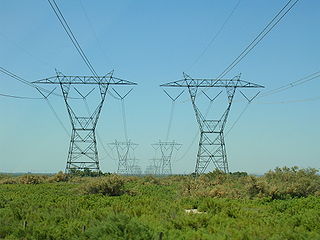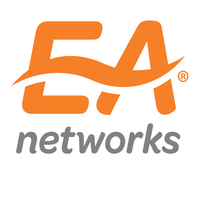Related Research Articles

Electric power transmission is the bulk movement of electrical energy from a generating site, such as a power plant, to an electrical substation. The interconnected lines which facilitate this movement are known as a transmission network. This is distinct from the local wiring between high-voltage substations and customers, which is typically referred to as electric power distribution. The combined transmission and distribution network is part of electricity delivery, known as the "power grid" in North America, or just "the grid". In the United Kingdom, India, Tanzania, Myanmar, Malaysia and New Zealand, the network is known as the National Grid.

The Bonneville Power Administration (BPA) is an American federal agency operating in the Pacific Northwest. BPA was created by an act of Congress in 1937 to market electric power from the Bonneville Dam located on the Columbia River and to construct facilities necessary to transmit that power. Congress has since designated Bonneville to be the marketing agent for power from all of the federally owned hydroelectric projects in the Pacific Northwest. Bonneville is one of four regional Federal power marketing agencies within the U.S. Department of Energy (DOE).

The Pacific DC Intertie is an electric power transmission line that transmits electricity from the Pacific Northwest to the Los Angeles area using high voltage direct current (HVDC). The line capacity is 3,100 megawatts, which is enough to serve two to three million Los Angeles households and represents almost half of the Los Angeles Department of Water and Power (LADWP) electrical system's peak capacity.

Southern California Edison, the largest subsidiary of Edison International, is the primary electricity supply company for much of Southern California. It provides 14 million people with electricity across a service territory of approximately 50,000 square miles. However, the Los Angeles Department of Water and Power, San Diego Gas & Electric, Imperial Irrigation District, and some smaller municipal utilities serve substantial portions of the southern California territory. The northern part of the state is generally served by the Pacific Gas & Electric Company of San Francisco.

The IPP DC Line is a bipolar HVDC transmission line between Adelanto Converter Station 34°33′4″N117°26′14″W in Adelanto, California and Intermountain Power Plant 39°30′2″N112°34′51″W near Delta, Utah.

Path 15 is an 84-mile (135 km) portion of the north-south power transmission corridor in California, U.S. It forms a part of the Pacific AC Intertie and the California-Oregon Transmission Project. Path 15 is part of The Western Electricity Coordinating Council's links of electrical intertie paths in the western United States.

Kerala State Electricity Board Ltd (KSEBLtd) is a public sector undertaking under the Government of Kerala, India, that generates,transmits and distributes the electricity supply in the state. Established in 1957, the agency comes under the authority of the Department of Power.It has been registered under indian companies act during January 2011

California Oregon Intertie (COI), identified as Path 66 by Western Electricity Coordinating Council (WECC), is a corridor of three roughly parallel 500 kV alternating current power lines connecting the electric grids of Oregon and California. Their combined power transmission capacity is 4800 MW.

Path 26 is a set of three Southern California Edison (SCE) 500 kV power lines, located primarily in Los Angeles County, and extending into Kern and Ventura counties, all in California. Path 26 is part of the Western Electricity Coordinating Council's links of electrical intertie paths in the western United States. The Path 26 lines are located in: the San Joaquin Valley of the southern Central Valley; the Tehachapi Mountains and other central Transverse Ranges; and the Antelope Valley section of the Mojave Desert.
The British Columbia Transmission Corporation (BCTC) was a Crown corporation in the province of British Columbia, Canada. Its mandate is to plan, build, operate and maintain B.C.'s electricity transmission system.
Path 62 or the Eldorado - McCullough 500 kV Line is a short 0.6 mi (1 km) 500 kV power line linking Los Angeles Department of Water and Power's (LADWP's) McCullough substation to Southern California Edison's (SCE's) Eldorado substation in the Eldorado - Marketplace - McCullough substation complex. Path 62 is part of The Western Electricity Coordinating Council's links of electrical intertie paths in the western United States. Like Path 61, this short, yet important 500 kV line allows for power flow to be rerouted on different 500 kV lines that make up the massive Path 46 transmission system when necessary. Power generated from Hoover Dam, and fossil fuel power plants in the Four Corners region is routed to this substation complex via many other 500 kV lines that connect to this substation complex.
Path 64 or the Marketplace - Adelanto line is a 202-mile (325 km) 500-kilovolt power line that runs from the Adelanto substation near Adelanto, California and the High Desert to the Marketplace substation near Boulder City, Nevada. Path 64 is part of The Western Electricity Coordinating Council's links of electrical intertie paths in the western United States. Path 64 is one part of the Path 46 transmission system in southeastern California. This power line is operated by Los Angeles Department of Water and Power (LADWP). This line, along with Path 27 and the other Path 46 lines, bring over 10,000 megawatts of electrical power to the Los Angeles area. Path 64 is an essential line for powering Los Angeles.
Path 46, also called West of Colorado River, Arizona-California West-of-the-River Path (WOR), is a set of many high-voltage alternating-current transmission lines that are located in southeast California and Nevada up to the Colorado River. This power transmission system is essential to meet the electricity demands of Southern California's massive population centers like Los Angeles and San Diego. The massive system has three separate systems of power lines.

Hydro-Québec's electricity transmission system is an international power transmission system centred in Quebec, Canada. The system pioneered the use of very high voltage 735 kV alternating current (AC) power lines that link the population centres of Montreal and Quebec City to distant hydroelectric power stations like the Daniel-Johnson Dam and the James Bay Project in northwestern Quebec and the Churchill Falls Generating Station in Labrador.

Amtrak's 25 Hz traction power system is a traction power grid operated by Amtrak along the southern portion of its Northeast Corridor (NEC): the 225 route miles (362 km) between Washington, D.C. and New York City and the 104 route miles (167 km) between Philadelphia and Harrisburg, Pennsylvania. The Pennsylvania Railroad constructed it between 1915 and 1938. Amtrak inherited the system from Penn Central, the successor to Pennsylvania Railroad, in 1976 along with the Northeast Corridor. This is the reason for using 25 Hz, as opposed to 60 Hz – which is the standard for power transmission in North America. In addition to serving the NEC, the system provides power to New Jersey Transit Rail Operations (NJT), the Southeastern Pennsylvania Transportation Authority (SEPTA) and the Maryland Area Regional Commuter Train (MARC). Only about half of the system's electrical capacity is used by Amtrak. The remainder is sold to the commuter railroads who operate their trains along the corridor.
The Mead substation is a major electric power interconnection point in the western United States. The station is located in the El Dorado Valley of Nevada just outside of Boulder City, at the end of Buchanan Boulevard south of its grade separation with Interstate 11. The facility is owned and operated by the Western Area Power Administration.

The 2011 Southwest blackout, sometimes referred to as the Great Blackout of 2011, was a widespread power outage that affected the San Diego–Tijuana area, southern Orange County, the Imperial Valley, Mexicali Valley, and Coachella Valley, and parts of Arizona. It occurred on Thursday, September 8, 2011, beginning at about 3:38 pm PDT. It was the largest power failure in California history.

The Western Electricity Coordinating Council (WECC) coordinates a number of high voltage power links in western North America. These links, known as WECC Intertie Paths, are not necessarily single transmission line, rather they are interties between various areas. These areas can be quite distant, such as Path 65 between The Dalles Oregon and Los Angeles California or short such as Path 61 between Lugo and Victorville, California, United States. These are currently numbered from 1 to 81, with a few numbers intentionally left out.

Electricity Ashburton Limited, trading as EA Networks is a co-operatively-owned electricity distribution company, based in Ashburton, New Zealand.
Adelanto Converter Station in Adelanto, California, is the southern terminus of the 2,400 MW Path 27 Utah–California high voltage DC power (HVDC) transmission line. The station contains redundant thyristor-based HVDC converters rated for 1,200 MW continuous or 1,600 MW short term overload. The 300-acre (120 ha) station was completed in July, 1986 at a cost of US$131 million. The northern terminus of Path 27 is fossil fueled Intermountain Power Plant in Utah.